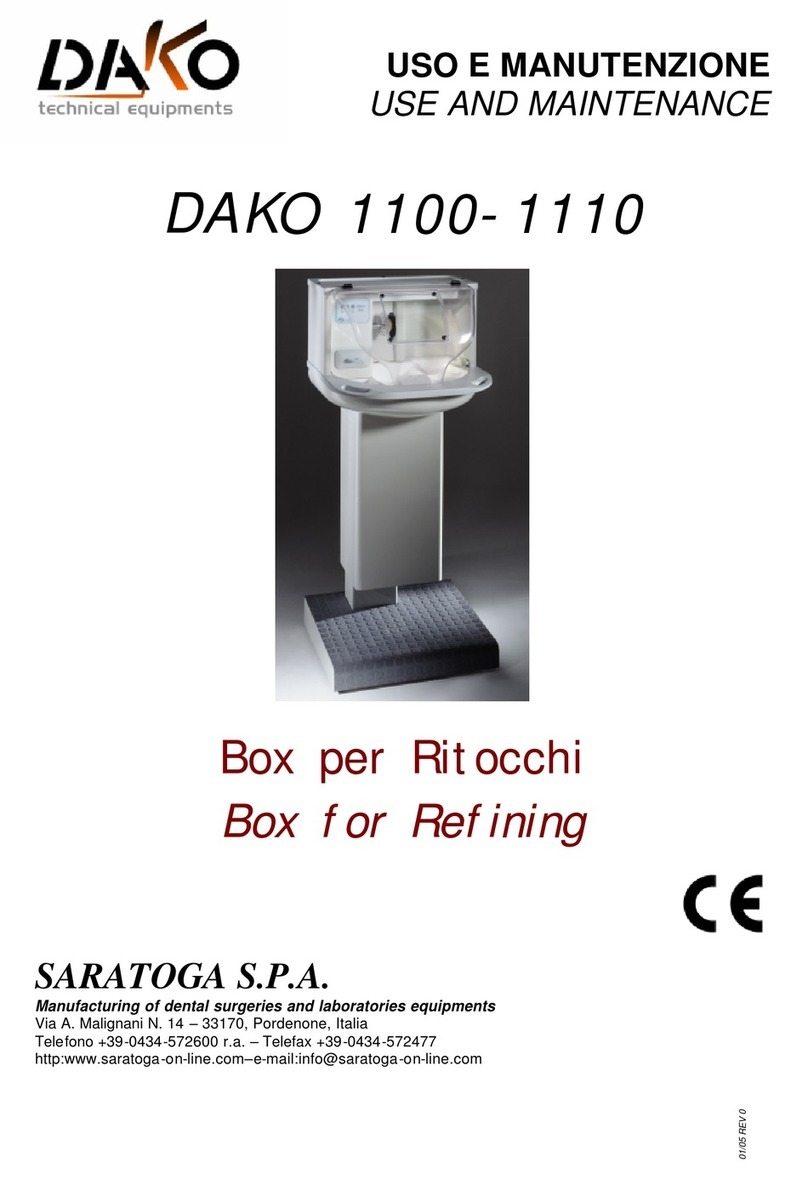
8
DAKO 5140
Sullo strumento vi sono i seguenti indicatori luminosi:
AL: Indicatore allarme temperatura. Si accende
quando, per qualche inconveniente viene supe-
rata di circa 60°C la temperatura da stabilizza-
re. In tal caso il riscaldamento è limitato dall’al-
larme stesso.
OUT1: Indicatore luminoso della regolazione di tempe-
ratura. Si accende all’inserimento della macchi-
na. Lampeggia quando, durante la fusione, si
raggiunge la temperatura da stabilizzare.
°C: Se acceso indica che le temperature visualizzate
sono espresse in gradi centigradi.
°F: Se acceso indica che le temperature visualizzate
sono espresse in gradi Fahrenheith.
Bilanciamento del braccio centrifugatore
•
Appoggiare sul braccio centrifugatore il supporto (5,
fig. 2) adatto al cilindro che si intende utilizzare in
modo che resti inserito tra i perni blocca supporto
(4, fig. 2), quindi inserirvi il cilindro (8, fig. 2).
•
Inserire il crogiolo con il metallo nell’apposita sede
(6, fig. 2).
•
Allentare il volantino del braccio (3, fig. 2).
•
Far scorrere il contrappeso mobile fino a ché il brac-
cio rimane in equilibrio. Il contrappeso scorre libera-
mente se tirato verso l’albero motore, per muoverlo
in senso opposto premere sulla levetta posta sotto
di esso.
•
Serrare il volantino.
Nota: il braccio su cui scorre il contrappeso mobile è
suddiviso in posizioni numerate per cui l’equilibratura
può essere eseguita per tutti i cilindri annotando per
ognuno la posizione del contrappeso, prima di intro-
durli nel forno di preriscaldo. Al momento della fu-
sione occorrerà portare il contrappeso nella posizio-
ne annotata per il cilindro in fase di utilizzo.
Inserimento
•
Portare l’interruttore generale (1, fig. 5) in posizione I.
•
Si accenderà la spia verde dell’interruttore, per qual-
che secondo tutti i led della tastiera poi rimarranno
accesi i primi sei led rossi (A, fig. 4), e l’indicatore
luminoso STOP (H, fig.4), se il braccio è già in posi-
zione lampeggerà il led del pulsante alza bobina (D,
fig. 4).
Disinserimento
•
Per disinserire la macchina premere l’interruttore di
disinserzione generale (1, fig. 5). Si spengono tutti i
led rossi sul pannello di comando e la spia verde
dell’interruttore.
Se la bobina di riscaldo è sollevata ed un crogiolo caldo
è immerso in essa premere prima il pulsante di stop (8,
fig. 4) e poi disinserire la macchina.
Impostazione della temperatura
Per selezionare la temperatura desiderata premere uno
dei due tasti 13 o 14 di figura 5 a seconda che si voglia
diminuire o aumentare la temperatura impostata. Per-
ché la temperatura inizi a variare occorrerà tener pre-
muto il tasto scelto per circa due secondi. Mantenendo
la pressione del tasto l’indicazione varierà più veloce-
mente.
Si ricorda che si dovranno impostare sempre tempera-
ture superiori di alcune decine di gradi al massimo del-
l’intervallo di fusione della lega perché il metallo possa
giungere ancora completamente fuso all’interno del ci-
lindro.
Movimenti leva alzabobina
•
Dal basso verso l’alto (fusione): portare il braccio in
posizione (il crogiolo deve trovarsi sopra alla bobina
di riscaldo) ruotandolo finché la spia del pulsante
alza bobina (4, fig. 4) lampeggia, quindi premere tale
pulsante.
•
Dall’alto verso il basso: premere il pulsante di stop
(8, fig. 4).
Avvio fusione
Per dare avvio alla fusione mettere il crogiolo nell’ap-
posito supporto, alzare la bobina e chiudere il coper-
chio.
•
Se si vuol fondere in modalità manuale premere il
pulsante fusione (3, fig. 4). Si accenderà il led corri-
spondente.
•
Se si vuol fondere in modalità automatica premere il
pulsante auto (5, fig. 4), la spia del pulsante di inizio
fusione lampeggia. Impostare quindi con i tasti di
incremento e decremento (9 e 10 di fig. 4) il tempo
di stabilizzazione della fusione facendo riferimento
alla scala C di fig. 4. Premere poi il tasto di inizio
fusione (3, fig. 4), la spia del pulsante di
centrifugazione inizia a lampeggiare, impostare
come appena descritto anche il tempo di
centrifugazione facendo riferimento alla scala B di
fig. 4. Premere quindi il tasto di centrifugazione (6,
fig. 4) ed il tasto di inizio fusione (3, fig. 4).
E’ possibile in qualsiasi momento tornare in modalità
manuale premendo il pulsante auto (5, fig. 4).
È possibile variare la potenza di fusione, anche a fusio-
ne già avviata, agendo sui pulsanti di incremento e de-
cremento (9 e 10 fig. 4).
La fusione può iniziare solo se la bobina di riscaldo è
sollevata ed il coperchio è chiuso. Se si apre il coper-
chio durante la fusione quest’ultima si interrompe auto-
maticamente per poi riprendere alla richiusura.
Non avviare mai la fusione senza aver messo prima il
crogiolo. Se il crogiolo utilizzato è del tipo ceramico
devono esserci almeno 15 gr di lega.
Arresto fusione
Può avvenire in due modi:
•
premendo il pulsante di stop fusione-centrifugazione
(8, fig. 4);
•
aprendo il coperchio (quando si richiude il coper-
chio la fusione riprende).




























